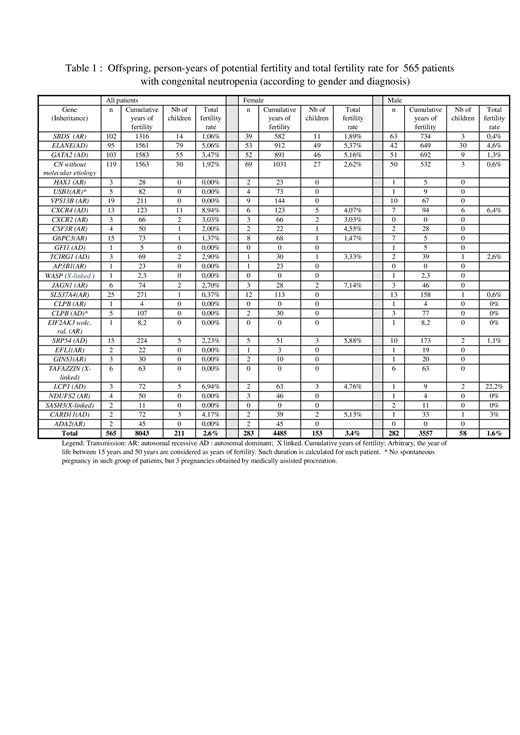CONCLUSION
Congenital neutropenia (CN) are characterized by chronic neutropenia with frequent co-morbidities. Approximately 30 different entities have been described with various clinical phenotypes and genotypes (PMID: 28875503). As survival rates and life expectancy improve, fertility and pregnancies becomes a common issue. Only one study had addressed this question, reporting 38 pregnancies in women with idiopathic neutropenia (n=6) or CN (n=16) (PMID: 24997149 ).
As of the last update at the end of June 2023, the French SCN registry enrolled 988 patients with a CN diagnosis, including 565 patients (282 males, 283 females) aged > 15 years old. The cumulative duration between 15 and 50 years of age for the total cohort is 8043 person-years, which can be considered as the years of potential fertility. For this study, we recorded the number of offspring, pregnancy outcomes, use of Granulocyte Colony Stimulating Factor (GCSF) during pregnancy, newborn outcomes and complications during pregnancy. Total fertility rate was calculated according to standard methodology (http://www.csss.washington.edu/Papers/wp97.pdf)
RESULTS
Among the 565 patients who may potentially be fertile, 109 patients (77 female among 283; 32 male among 282) became parents and a total of 211 offspring were recorded (table 1). In addition, medical termination of 5 pregnancies was performed in 5 patients with dominant CN disorders (ELANE and GATA2) following prenatal diagnosis. Globally, the total fertility rate in women was 3.4%, higher than the 2.1% rate in the general population in France. The fertility rate was heterogeneous, as some rare forms of CN may suffer from sterility (e.g. USB1 or CLPB heterozygous), or low fertility (e.g. SBDS, G6PC3 or GSDIb) whereas quite normal fertility was observed in others such as ELANE or GATA2. The parents' median age at first birth was 27 years (min, max: 18, 41 years). Among the 77 females who became pregnant, 39 received GCSF prior to the first conception; 14/32 males had received GCSF. No GCSF was initiated during pregnancy. GCSF was maintained on various schedules during the pregnancy in 24 pregnancies. Among the 24 babies born after receiving GCSF in utero, no malformations were observed. As expected, some offspring (n=54) were shown to have the the same genetic defect as their affected parent, in agreement with the autosomal dominant inheritance, mainly ELANE-CN or GATA2. Noteworthy, two post-HSCT (indicated for MDS) pregnancies were underwent in ELANE-CN whereas one mother has received chemotherapy for a solid tumour before pregnancy. We observed one severe intrapartum complication (eclampsia) in a woman with USB1-CN. Among the 211 births, prematurity (< 37 weeks) was present in 13 cases, IUGR (mean weight 2141 g and mean height 42 cm) in 15 cases, and macrosomia in 11 cases (mean weight 3774 g). Two early deaths due to prematurity and enterocolitis and 1 cerebral anoxo ischemia from a twin pregnancy were observed.
In France, two-third of the patients with congenital neutropenia are adult. The total fertility rate in this population appears to be similar to the general population; although fertility is reduced in some subtypes of CN. No teratogenic effect of GCSF has been observed, but numbers are rather small.
Disclosures
Sicre De Fontbrune:Samsung: Honoraria, Research Funding; Alexion, AstraZeneca Rare Disease: Honoraria, Research Funding; Sobi: Honoraria, Research Funding; Novartis: Honoraria, Research Funding.


This feature is available to Subscribers Only
Sign In or Create an Account Close Modal